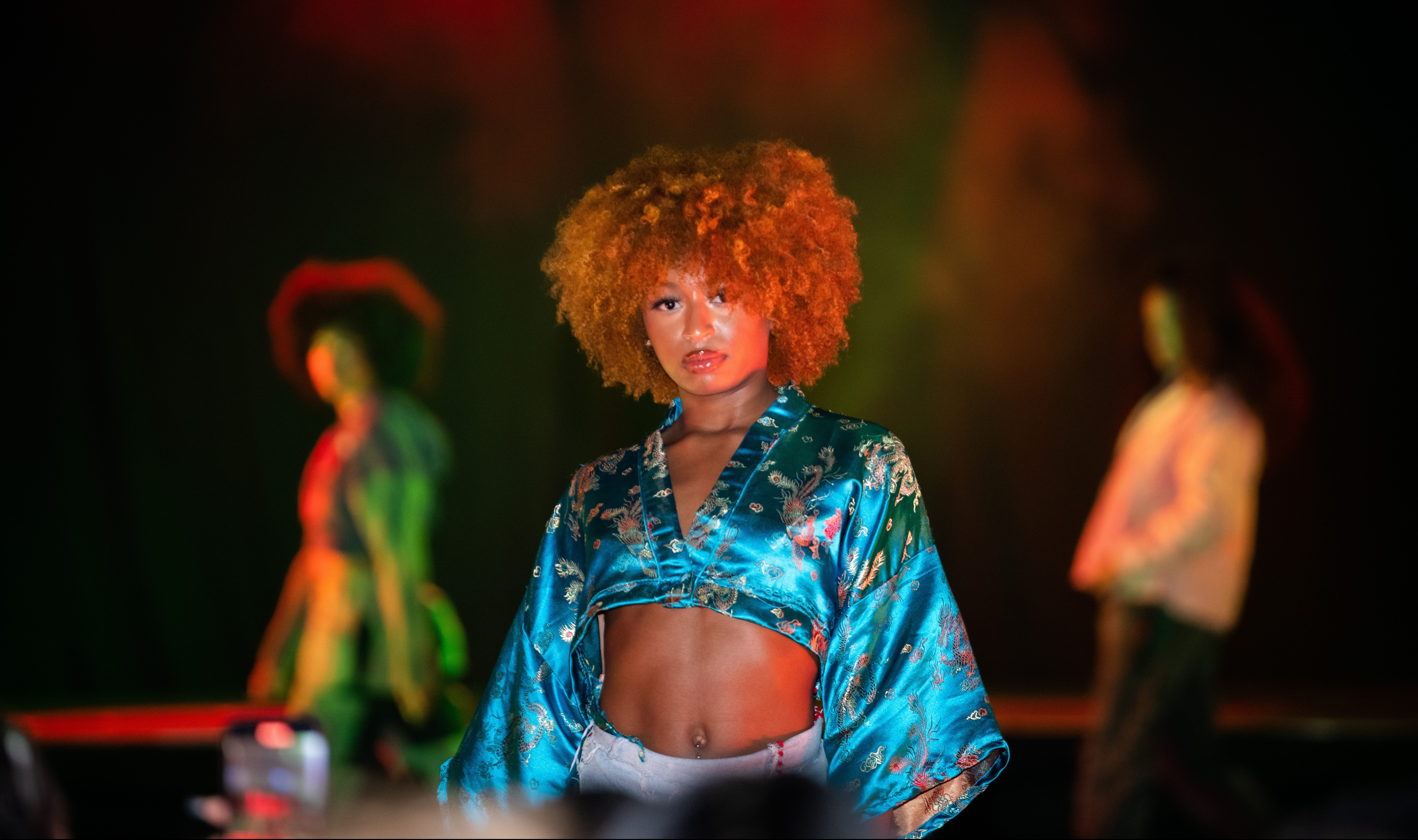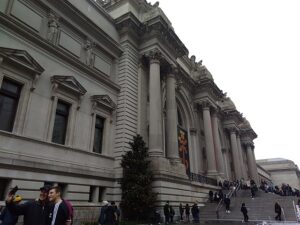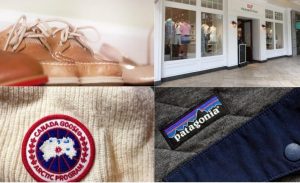On April 21, the McDonough Arena was transformed into a scene of glamor: A runway stretched across what once was a basketball court, lined with chairs holding an eager—and notably well-dressed—audience. Screens, speakers, and color-changing lights flanked the stage of one of the year’s most dazzling events. Anticipation overwhelmed the space.
The annual fashion show Diamanté highlights individuality by providing creatives of color at Georgetown an opportunity to express themselves through clothing. The production’s name literally means diamond, in that everybody is one. This year’s theme, “A Muse Is Born,” focuses on introspection, or more specifically, exploring oneself in their rawest form—their soul. It’s a way for people to determine how they present themselves, learning from life experiences. Sourced from 15 designers from across the East Coast, the garments ranged from puffer jackets to swimsuits. Models felt that their outfits were outlets for showcasing different aspects of their identity—especially sexuality and race.
Lily Tom (CAS ’24) was one of Diamante’s showrunners this year. She spoke to the Voice about her experience putting the production together, which she and other organizers have worked on since last June. Tom expressed Diamanté’s significance in fostering creatives of color, more than in spaces offered by the University itself: “The community that I’ve curated is my safe space. I’ve lived a lot in the intersections of different communities, in terms of being multiracial. I understand certain things and others I feel alienated from,” she said. “Diamanté is a good representation of intersectionality, and it’s a space where intersectionality thrives.” The show was made to allow people of color to explore their boundaries in fashion and experiment with different forms of artistic expression. “Finding Diamanté has allowed me to feel comfortable, to navigate my way through everything else because it’s a safe base to go back to.”
 Courtesy of Daniel Oppong/Africa At Its Hottest
Courtesy of Daniel Oppong/Africa At Its Hottest
Model Olivia Cooley (CAS ’23) echoed Tom’s sentiment. “Diamenté actually really helped a lot with so far this year, with my self-confidence, especially with walking properly, [and] adjusting my posture,” she said. “I find myself finding times where I’ve been slouching, and I’m able to correct it and just know, ‘Okay, my presence isn’t something that should be covered.’”
Last year, the fashion show was fully rebooted after the pandemic, and it has only grown since then. “It started at Georgetown, and then it went to the greater Washington area, and then the DMV. Now, this year, we’re all across the east coast,” Tom said. She elaborated on how that expansion manifested in the preparation of this year’s show: “By allowing more people to come in—people of all different backgrounds, history, and experiences—and just explore, create, and collaborate, it sets the world on fire. I can’t explain the feeling, it is like, ‘Oh my gosh! This is an overwhelming sense of wow!’”
That “wow” was apparent the moment the first line from Malakhi the Stylist took the stage, setting the tone for the evening. As the arena lights dimmed and the speakers sounded with energetic music, the audience erupted in delight watching the outfits roll onto the runway. Malakhi’s line featured black-and-white chevron-patterned designs with a range of expertly fitted silhouettes. The splendid outfits against the colorful lights created a striking scene. Models strutted and posed to impassioned cheers from the audience.
Several designers foregrounded different causes in their work, using elements of their outfits to make a statement. One such brand was QuintessentialxBeware, which showcased the unique charm of streetwear in their boundary-pushing line. Cropped and form-fitting pieces layered with oversized elements created effortlessly cool displays. A pair of sneakers with tied-together laces hung around the necks of many models served as one of the line’s core motifs. The accessory was a nod to hip-hop and sneakerhead culture of the ’80s and early ’90s, and has since been adopted as a symbol by the Black Lives Matter movement to protest against police brutality and racial injustice in more recent years. The QuintessentialxBeware founder started the brand with a mission to “challenge people’s perceptions of what is considered fashionable,” one that was achieved flawlessly in this line of edgy and unconventional designs.
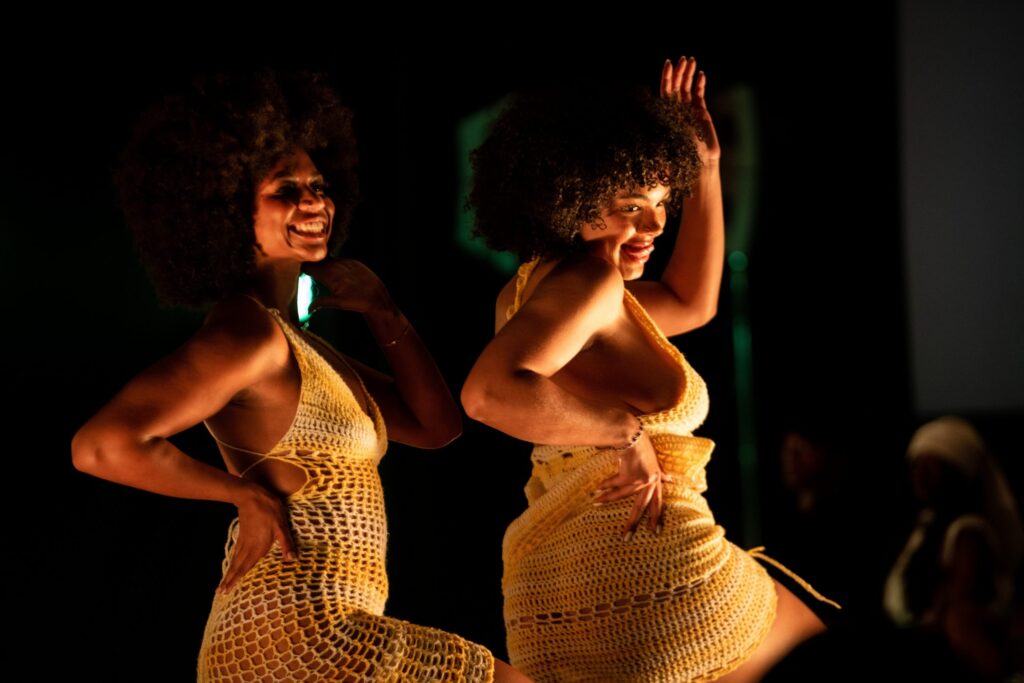 Courtesy of Daniel Oppong/Africa At Its Hottest
Courtesy of Daniel Oppong/Africa At Its Hottest
One of our favorite lines of the night was by Crochet For Baddies, which featured some of the most colorful outfits of the show. A blue two-piece set with white flowers crocheted throughout looked both cozy and sexy, and the bucket hat added a cute touch. Model Cynthia Jisseh glowed in the lights as the crowd roared—it was clear that the models themselves were also having a fun time. Flaunting the flairs on the edges of the pieces, the first model of the line struck a confident pose in a periwinkle top, skirt, and shrug, highlighting the juxtaposition of cute, comfort, and sexiness. A matching duo walked the runway in crochet lemon-yellow two-pieces, posing with huge smiles on their faces. Of all the show’s designs, the crochet pieces are perhaps the most on-trend in the mainstream, but the stark colors and fun patterns added a one-of-a-kind twist.
The stand-out look of the show, a large unicorn headpiece paired with a voluminous tulle gown, massive silver-buckled belt, and velvet black gloves was an exciting manifestation of fashion in the realm of creativity. The look was dramatic and campy, a perfect illustration of Diamanté’s success in fostering a space of play.
 Photo by Shoma Oura
Photo by Shoma Oura
Though the designs were truly enchanting, the models were what really made the show. From expertly-executed walks to energizing dance breaks, the show’s choreography was spectacular, and models truly embodied the energy of their outfits in their steps. One model left the audience in awe when showcasing a bedazzled bikini set with dangling rhinestones. Undeterred by the height of her (at least) 10-inch heels, she strutted down the runway with grace and ferocity, stopping only to pose for the cameras at the very end. Moving her hips, she emphasized the garment’s full glory as the bejeweled fringes swung from side to side, culminating in a dynamic and captivating performance. Another walk surprised and delighted the audience in its flawless display of teamwork: As one model was walking back, two others made their way down the runway, halting the first as they passed each other—and in an unexpected twist, the first model began walking backwards as the three made their way down the catwalk together.
The closing walk for the Eve line was a particularly stunning reminder of Diamanté’s commitment to protecting queer expression. The models’ strutting spun into an exhilarating waacking performance that sent the crowd into eruption. Created in LA gay clubs in the ’70s disco era, waacking has since become a staple dance style in the LGBTQ+ community. The model’s relentless arm movements and invigorating expressiveness demanded attention, and infused the show with the joy of queer heritage.
In a post-show interview, model Akil Cole (CAS ’24) told the Voice about what made the modeling for Diamanté feel special: “Traditionally, in runway fashion, the runway model is occupied by very tall, very slim, very European-feature centric folks,” he said. “From my understanding, folks were just chosen [for Diamanté] for their passion and dedication to walking.” To Cole personally, Diamanté has felt like a space to unwind and feel connected to his physicality. “It was just cool to be able to come in like, ‘I’m going to do my walk, think about what vibe I’m presenting,’ and then be able to pull up, and to just be in my body.”
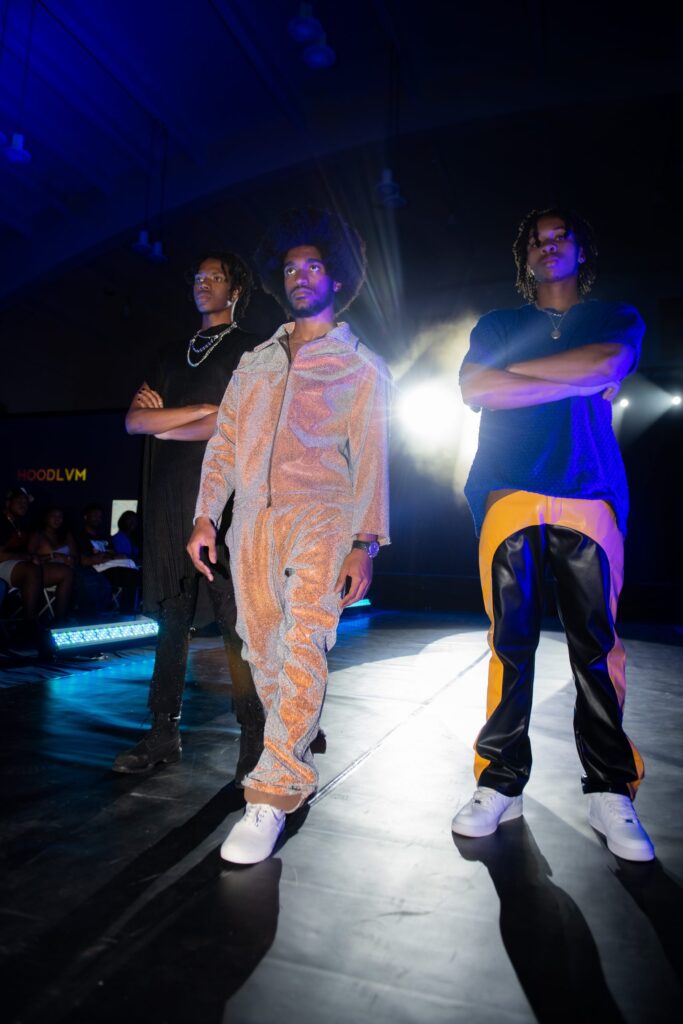 Courtesy of Daniel Oppong/Africa At Its Hottest
Courtesy of Daniel Oppong/Africa At Its Hottest
Tom also emphasized the importance of self-love and respecting one’s own body in this show. “Oftentimes the media, the external world, and other communities make us feel like we’re dust. we’re dirt; but [Diamante] is all about finding your inner diamond,” she said. “Especially this season, we’ve tried to focus on how everyone is a diamond, and it’s just the mining and uncovering of it all.”
And diamonds they were. The show ended with a walkthrough of the models and a final hoorah for the organizers. Lights circled around, highlighting all of their faces, while a violinist’s rendition of “Diamonds” by Rihanna accentuated the plain black uniforms of the models. Stripped back to less decorative garb, the moment created a space of appreciation for what the models did; by bringing the designers’ garments to life, they were the ones to applaud. It was exhilarating, overwhelming, and so beautiful—the perfect way to end the show.
As we walked away in an adrenaline-induced stupor and adrenaline rushing through our veins, it was safe to say that Diamanté had left its mark. “I want the show to impress upon [the audience] the ability to find that safe space for themselves and to go on the journey of finding out how to express their inner diamond,” Tom said “I think a lot of people are scared to take those first steps, but I hope that Diamanté proves that this is what can come out of it.”


